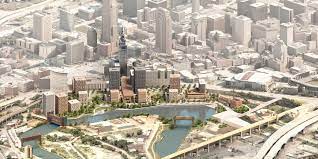Plans for the Cuyahoga Riverfront project have been unveiled through a partnership between Detroit-based developer Bedrock and the City of Cleveland.
According to the plans, the initiative will feature 3.5 million square feet of new development. Additionally, it will feature adaptive reuse projects over 35 acres of publicly and privately owned waterfront land.
Approximately 2,000 residential units and 850,000 square feet of office space will be developed. Additionally, 12 acres of open space are included in the site’s preliminary designs. Furthermore, the development, the cost of which is approximately $3.5 billion will feature hospitality, retail, and restaurant areas.
The final buildout and makeover of the site are anticipated to take between 15 and 20 years. This is according to the Cuyahoga Riverfront project development team.
The Cuyahoga Riverfront project team
Also Read: Construction breaks ground at The Aura at Innovation Square, Cleveland
Bedrock has worked on the Cuyahoga Riverfront project with Sherwin-Williams Co. The two collaborated to buy the Breen Technology Center and Landmark Office Towers. However, it was not immediately clear what these structures might be used for in the future. The team sees the site as a natural bridge between the Cuyahoga River and downtown Cleveland.
The partnership also is made up of master architect David Adjaye, local business Osborn Engineering, and urban planning firm MKSK. Adjaye has been working on a strategy to realize that goal for the past few months in Cleveland.
“Our plan for the Cleveland riverfront draws on the city’s long-lost history to forge a fresh connection between the city center and the coastline. The necessity to create a more moderate flow of movement across the city became obvious as I grew more interested,” said Adjaye.
Kofi Bonner, the CEO of Bedrock, on the other hand, said, “David’s vision not only embraces the rich history and connection to nature of downtown Cleveland but also addresses the demands of a world-class city by leveraging sustainable infrastructure and emphasizing pedestrian and transit modes to large, activated open spaces.

Leave a Reply